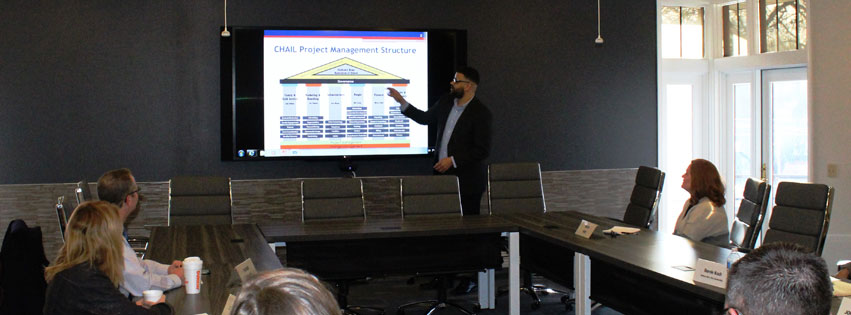There’s something about a child in crisis that makes you look at the world a bit differently… and drives you to help. At the Children’s Home Association of Illinois, nearly 1,700 children, young adults and families get the assistance they need to cope with and heal the trauma they’ve experienced. A team of over 400 employees works tirelessly to provide a childhood and future for these young people.
The Global Program Management (GPM) team at Caterpillar wanted to use their professional skills as project managers to help, too—and ended up saving Children’s Home tens of thousands of dollars. Nearly all nonprofits have limited resources, so identifying and executing priorities can be a serious challenge. That’s where project portfolio management (PPfM) comes in.
Children’s Home Case Study
The passionate staff at Children’s Home does so much good in our community, and the GPM team wanted to help them be even more effective. Their team was experiencing challenges in coordinating and tracking the significant number of initiatives and projects in their portfolio of more than 40 programs. After reviewing their project-selection process and the nature of their current projects, the GPM team identified a need for a robust portfolio management process.
Our Caterpillar volunteers focused on defining strategic goals and imperatives within the Children’s Home portfolio. Each project was aligned with a specific program, with the team checking to see whether the project matched up with the program goals. Then the GPM team trained Children’s Home staff so they could apply the same processes on future projects. All the business leads were paired with a Caterpillar project management professional, who helped them create and monitor their plans. The staff also received training on key software tools used in project management.
“Like all nonprofit organizations, every dollar counts and must be maximized to optimize community benefits,” notes Children’s Home CEO Matt George. “GPM helped us maximize the value we deliver by ensuring the right projects are being done at the right time, which is critical for our continued success.”
What About Your Nonprofit?
To all leaders managing a nonprofit organization: You likely have a great team with excellent ideas to improve the business and deliver more value. How do you choose which projects to work on? Which of these ideas are best aligned with your nonprofit’s strategy? Are the objectives and goals associated with these ideas well-defined? Do you have the necessary resources to deliver the objective(s)? Answering these questions and making stronger business decisions are difficult. But, as demonstrated at Children’s Home, effective project portfolio management can help.

The PPfM process is an ongoing activity that ensures projects across a portfolio are aligned with overall organizational strategy and business expectations. Leveraging the following steps can help your nonprofit thrive:
Step 1: Clarify Business Objectives
Before jumping into portfolio management, clearly state your organization’s strategic objectives. This is often the first obstacle people run into when trying to implement PPfM. If you can’t determine the strategic objectives, stop to fix that problem first.
Portfolio management requires a systematic method of differentiating between potential projects to determine which ones are “best.” Based on your objectives, select four to 10 criteria that will measure each project’s true value to your unique organization. The right criteria are critical!
Step 2: Capture and Research
Create an inventory of potential projects for the portfolio. Include in-progress projects as well as ideas for new projects. Sources can include customer requests, initiatives from strategic planning, ideas from employees, etc. Gather data for each potential project—including data that will allow you to rate them against the criteria you’ve developed. It may also include early estimates of project interdependencies and high-level resource requirements.
Step 3: Select the Best Projects
Determine which combination of projects creates the highest total value for the portfolio, given any resource constraints. First, evaluate each potential project with your criteria to compute the value of each project. Next, rank the projects from highest to lowest value. Starting with the highest-value projects, allocate available resources until they are exhausted. Draw the “cut line” at this point, creating a tentative portfolio. It’s tentative because no valuation criteria, no matter how good, can capture all the subtleties that go into real-world funding decisions. The cut line becomes a starting point for vigorous discussion as team members use their experience and judgment to finetune the tentative portfolio.
Step 4: Validate and Initiate
The resulting portfolio ignores some important constraints and details about its projects. For example, a portfolio’s demand for resources often appears feasible, but there may be issues with the limited availability of certain skillsets. So, a portfolio may not be feasible, even though it is maximized and balanced. Before starting execution, team up with the people who will run the projects to validate their feasibility.
Step 5: Manage and Monitor
After validating the portfolio, put it into execution. Initiate the new projects and programs, inserting them into the project management system. While the project manager is responsible for day-to-day execution of each project, the portfolio manager’s job continues. He or she monitors the execution of the portfolio and its projects, ensuring it continues to meet its original objectives. In this step, the portfolio manager works closely with the project managers, gathering information to monitor performance.
While the PPfM process might seem like a daunting undertaking, it’s simpler than it sounds. Review the ample project management sources online and/or benchmark with Children’s Home. The bottom line is this: Empowering your organization with strong project management practices can save a significant amount of expenses—expenses that could then be used to provide more services to the people your nonprofit serves. PM
Jeff Zircher is global program management manager at Caterpillar Inc.




